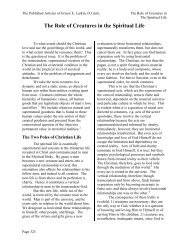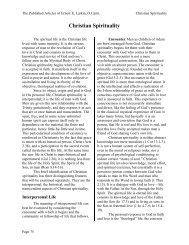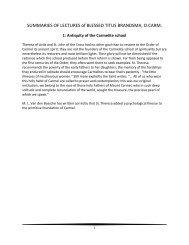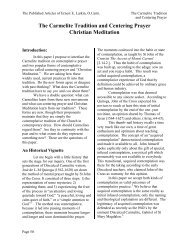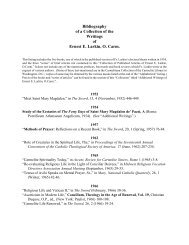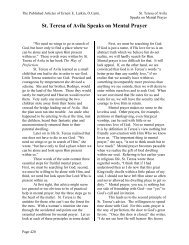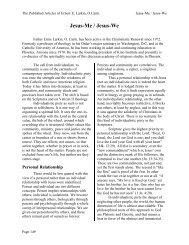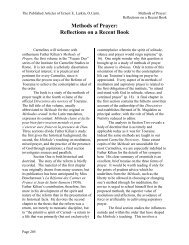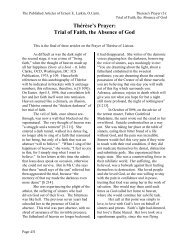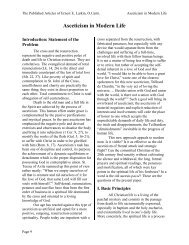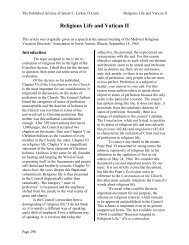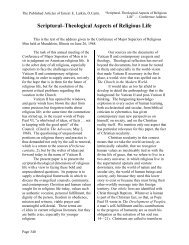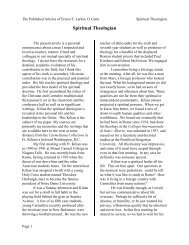Full Article - Carmelnet
Full Article - Carmelnet
Full Article - Carmelnet
You also want an ePaper? Increase the reach of your titles
YUMPU automatically turns print PDFs into web optimized ePapers that Google loves.
The Published <strong>Article</strong>s of Ernest E. Larkin, O.Carm. Structure And Spirit in<br />
Religious Renewal<br />
Page 384<br />
Structure and Spirit in Religious Renewal<br />
Address to the Regional Meeting of the Sister Formation Conference, February, 1969.<br />
John Gardner records an observation<br />
of Nicholas Murray Butler to the effect that in<br />
the Garden of Eden, Adam stopped Eve one<br />
day and said: “Eve, we are living in a period<br />
of transition.” There is no question but that<br />
religious life is going through a period of<br />
transition.<br />
How is the process faring? It is<br />
difficult to say. Communities are at different<br />
stages of renovation, and evaluations vary.<br />
Many, however, sense something of an<br />
impasse at the present moment. There have<br />
been many changes in religious life, but where<br />
is it all going? Some think the changes are<br />
destroying religious life, others that there has<br />
been no real change at all. Bells have been<br />
dropped, horaria humanized, habits altered,<br />
even put aside in favour of secular dress. But<br />
has radical renewal taken place? Are religious<br />
vibrant, joyful, Easter people, loving<br />
communities of dedicated Christians? Or is it<br />
another case of the French proverb: “The more<br />
the changes, the more things are like<br />
themselves?”<br />
The changes so far have had to do<br />
mostly with structures. But can religious life<br />
be renewed from the outside in? On must we<br />
not follow the Gospel principle of metanoia,<br />
which is conversion from the inside out? The<br />
answer is that we need both a new heart and<br />
spirit, “interior renewal,” and the new<br />
structures that are gradually and sometimes<br />
painfully being worked out in contemporary<br />
religious life. The structures are the vehicle<br />
and incarnation of the spirit. Some of them<br />
are peripheral, others are creating new life<br />
styles in community and in the apostolate, not<br />
only in government, the exercise of authority<br />
and obedience, forms of poverty and the<br />
common life, but in the most basic values of<br />
religious life, which are prayer and<br />
community. For a New Pentecost in religious<br />
life we need a revitalized faith, hope and<br />
charity and structural reforms imaginative and<br />
creative enough to express this new life in the<br />
culture of the 1970’s.<br />
Reform the Work of the Spirit<br />
It is not enough, therefore, to<br />
humanize, socialize and secularize religious<br />
life. These things we must do to be part of our<br />
times. So we are increasing the opportunities<br />
for individuals to grow as authentic persons;<br />
we are changing patterns of common<br />
observance, so that communities can be<br />
communions of friendship and love; we are<br />
reforming our apostolate, so that the works are<br />
worth doing, real contributions to building up<br />
the new earth. But we must do all this in such<br />
a way that it is God’s work as well as our<br />
own.<br />
Replacing the obsolete and the<br />
obsolescent, getting rid of irrelevancies and<br />
hang-ups from the past, making religious life<br />
more human, and therefore, more Christian,<br />
bringing convent life into tune with the space<br />
age--all that is part of renewal, with a proviso.<br />
The proviso is that the reforms are the work of<br />
the Holy Spirit. This is not pietism. It is<br />
Gamaliel’s principle: “If this plan or work is<br />
of men, it will be overthrown; but if it is of<br />
God, it will last.” (cf. Acts 5:38-39)<br />
External reforms without the new spirit<br />
do not renovate the Church or religious life.<br />
Here is a test case. What do you think of<br />
these words that appeared recently in a<br />
column in the Catholic Press: “Every priest<br />
who marries without `permission’ represents a<br />
victory for the reform moment. Every<br />
seminarian who leaves the seminary in protest<br />
against an antiquated clerical life represents a
The Published <strong>Article</strong>s of Ernest E. Larkin, O.Carm. Structure And Spirit in<br />
Religious Renewal<br />
reform triumph.” At best statements like this<br />
are equivocal. Opting out may be the answer<br />
in given cases, but only if “it seems good to<br />
the Holy Spirit and to us” (cf. Acts 15 :28),<br />
only if a formed Christian conscience dictates<br />
this extreme remedy. Otherwise we are truly<br />
substituting man-made religion for divinelyguided<br />
faith. The presumption is against<br />
copping out, as Bishop Butler of England<br />
stated eloquently in an interview last fall. He<br />
urged Catholics to stay in the structures and<br />
work for renewal from within with courage<br />
and patience and co-responsibility. My point<br />
here, however, is not to take a stand against<br />
protest or revolt, but to insist that every<br />
decision to make changes, especially<br />
disruptive ones, must be carefully measured<br />
by a higher law and validated in the Holy<br />
Spirit. We need discernment of spirits today<br />
as never before in the past, for without the<br />
Holy Spirit there is no true reform in the<br />
Church.<br />
Renewal, Spiritual and Juridic<br />
This reflection may sound nambypamby,<br />
as if to take the renewal out of our<br />
own hands and to return us to the<br />
unquestioning, often naive, and sometimes<br />
even magical thinking of pre-Vatican II days.<br />
The fact is that renewal is both spiritual and<br />
juridic, divine and human. Without the Spirit<br />
external changes will be as dead a letter as the<br />
evils the reforms are supposed to correct.<br />
Spiritual renewal means renewal that is<br />
Spirited, Holy-Spirited, changes and reforms<br />
that are enlivened and directed by the Holy<br />
Spirit. Unless the Holy Spirit recreates, refashions,<br />
and re-forms both the people and<br />
their institutions, our efforts at aggiornamento<br />
will be not only ineffectual but destructive.<br />
At the end of the Uppsala World<br />
Council of Churches meeting of 1969 the<br />
following evaluation was made by one of the<br />
youth representatives: “Renewal,” he wrote,<br />
“will not come from youth; it can only come<br />
from the living God. A new encounter with<br />
Page 385<br />
the living God is a desperate need for all<br />
within the Church, for youth as much as for<br />
the old:” We say with equal conviction:<br />
religious renewal will not come from<br />
religious; it can only come from the living<br />
God.<br />
Changes in structure without change of<br />
heart are the adaptations without renewal of<br />
which Perfectae caritatis states: “Even the<br />
best adjustments made in accordance with the<br />
needs of the age will be ineffectual unless they<br />
are animated by a renewal of Spirit.” (2, e)<br />
Adjustments without renewal are non-salvific.<br />
Interior renewal, on the other hand, is always<br />
salvific. Inevitably it puts new life into dead<br />
bones of archaic institutions and creates new<br />
forms. A renewed spirit is the new wine of<br />
the Gospels that bursts through the wornout<br />
wineskins of the old structures and demands<br />
new skins to keep it.<br />
We cannot use the Holy Spirit’s role as<br />
an excuse for inaction, for do-nothingism. We<br />
can be sympathetic with those who are<br />
threatened by the erosion of religious practices<br />
and structures that served so well even in the<br />
recent past. But let the dead bury their dead.<br />
The living must move forward, eyes straight<br />
ahead, without regrets even if there is a touch<br />
of sadness for what must pass. New ways of<br />
living and doing must incarnate the ancient<br />
values of religious life in our contemporary<br />
culture. New forms will rise out of the ashes<br />
of the old, and our only concern must be to<br />
search out the values and their appropriate<br />
manifestations for our time. This is to listen<br />
to the Spirit. He speaks, not in voices from<br />
heaven, but in human ideals and secular<br />
hopes. These are today’s signs of the times.<br />
No Dichotomy<br />
There is no dichotomy, then, between<br />
spiritual renewal and exterior changes. There<br />
is no room for two camps among us, one of<br />
“spiritualists,” the other “structuralists”. We<br />
must not fall into the error of pushing the<br />
reform of structures to the neglect of renewal
The Published <strong>Article</strong>s of Ernest E. Larkin, O.Carm. Structure And Spirit in<br />
Religious Renewal<br />
of spirit, as if the spirit is a private affair and<br />
really has nothing to do with practical matters.<br />
At the same time we cannot promote renewal<br />
of spirit in a vacuum, as if a good retreat<br />
would solve the ills which assail religious life<br />
today. Spirit and structures go hand in hand;<br />
they rise and fall together. They do not<br />
represent two approaches to the same one<br />
goal; they are one approach, or else no<br />
approach at all. They are not separate<br />
compartments, but like soul and body, they<br />
interpenetrate each other. One is interior to<br />
the other. Neither stands alone. While we can<br />
conceive our task as beginning with the spirit,<br />
we must remember that the spirit cannot<br />
survive among men if it is not quickly<br />
incarnated in tangible forms and deeds. We<br />
can live with abuses in a state of contradiction<br />
for a while, but only for a while. Either the<br />
spirit or the contradiction will give way.<br />
This regional meeting of the Sister<br />
Formation Conference is dedicated to the<br />
theme of interior renewal. My modest<br />
contribution to this theme is to suggest a<br />
thought about the relationship between interior<br />
and exterior renewal. My proposal is that in<br />
our thinking and action we do not separate<br />
renewal of spirit and structural changes but<br />
strive to approach renewal in an integrated,<br />
contemporary fashion.<br />
Some documents of Vatican II tend to<br />
highlight the distinctions and antitheses in<br />
Christian life rather than its unity. The<br />
antitheses in question correspond roughly to<br />
spirit and structures, to the divine and the<br />
human elements in Christianity. According to<br />
the Constitution on the Sacred Liturgy, for<br />
example, the Church is<br />
…both human and divine, visible and yet<br />
invisibly endowed, eager to act and yet devoted<br />
to contemplation, present in the world and yet<br />
not at home in it. She is all these things in such<br />
a way that in her the human is directed and<br />
subordinated to the divine, the visible likewise to<br />
the invisible, action to contemplation, and this<br />
present world to that city yet to come… (n. 2,<br />
pp. 137-138 in Abbott)<br />
Page 386<br />
Perfectae caritatis describes religious<br />
life in a series of contrasting doublets that play<br />
on its different aspects. Generally the<br />
dialectic is between being and doing. Thus<br />
religious life is both a state of being and a<br />
function, a witness and a mission; it is a<br />
consecration to God and service to men, at<br />
once contemplative and apostolic. These<br />
elements describe two movements, one<br />
vertical, moving upward toward God, the<br />
other horizontal, moving outward toward men.<br />
The person who stands at the intersection of<br />
these pulls is bound to experience the tension<br />
between heaven and earth.<br />
The Double Vocation of the religious<br />
These clear distinctions underline the<br />
double vocation of the Christian and the<br />
religious. He must love God and he must love<br />
his neighbor. United to God in spirit, he<br />
carries out in the structures and patterns of<br />
daily existence the demands of faith, hope and<br />
charity. On the basis of the double movement<br />
we can develop a valid philosophy of religious<br />
life. The religious woman stands at the<br />
crossroads, looking up to God and looking out<br />
into the world. Her life is a search for union<br />
with God and for community with her<br />
fellowmen. Prayer, is her vertical occupation,<br />
fraternal charity and the apostolate the<br />
horizontal obligation. There is no danger of<br />
confusing these two. God is not people, nor<br />
are people God. Love of God is not love of<br />
neighbor, nor is prayer identified with<br />
building community or promoting human<br />
values. Life is a rhythmic movement from<br />
one to the other of these two occupations: now<br />
one prays, now he works, now he prays again.<br />
Priority is given to prayer; community is the<br />
effect of prayer, and structures grow out of<br />
union with God.<br />
This summary, brief and partial as it is,<br />
seems to characterize the “old spirituality.”<br />
The old spirituality nourished countless souls<br />
in the past, and still has much to recommend<br />
it. It is valid. But is it viable today? Does it
The Published <strong>Article</strong>s of Ernest E. Larkin, O.Carm. Structure And Spirit in<br />
Religious Renewal<br />
not run counter to contemporary religious<br />
culture? Today’s generation is impatient with<br />
distinctions that separate instead of unify<br />
human life. Life is experienced today as<br />
moving in one direction, at once forward and<br />
toward God. Thus the religious woman of<br />
today would see herself as a person living in<br />
community and her whole life, this life with<br />
others in the world, is God-oriented. She<br />
seeks a different image or diagram to illustrate<br />
her relationships with God and the world.<br />
Three Concentric Circles<br />
One possible image is three concentric<br />
circles. The center circle is Christ, the<br />
sacrament and revelation of the Father. The<br />
middle circle represents the world; it stands<br />
for people, the cosmos, for individuals and<br />
communities, for the “you’s” in my life. The<br />
outer circle is the religious woman herself, the<br />
person, the “I”. The rings are not standing<br />
still; they vibrate into each other, now from<br />
the center outwards, now from without to<br />
within. They interpenetrate one another. The<br />
two outer rings represent the human side, the<br />
structures of religious life. The center ring is<br />
the spirit. Christian life is a constant<br />
interaction between the center and the two<br />
outside rings, between spirit and structures.<br />
The diagram shows that life with each other<br />
and with Christ is one.<br />
A man’s life is lived in the outer rings,<br />
but with power from the center. He does live<br />
in isolation on the outer ring, at least if he has<br />
a human existence. He is defined as a person<br />
by the persons in his life. “You” make me<br />
what I am; you give me meaning and value,<br />
because I make a difference to you. Without<br />
you I cannot be; but in communion with you I<br />
grow, as indeed do you in our mutual love.<br />
Christ enters my life through you. He enters<br />
these outer rings as the ultimate You in our<br />
life, the one who gives me and you ultimate<br />
meaning. He calls us together in himself; He<br />
speaks to us in the I-You condition of human<br />
Page 387<br />
existence. I become a Christian when I<br />
recognize Him as the center of my life.<br />
I recognize the Christus praesens in<br />
faith. He is the Risen Lord, who speaks to me<br />
through His Spirit, especially in the people in<br />
my life. This means that He speaks to me in<br />
the cosmos, in history, as well as in Word and<br />
Sacrament. Contemporary theology locates<br />
Christ where He promised to be: with men,<br />
where two or three are gathered in His name,<br />
where the least of His brethren stand in need,<br />
where love and charity prevail, wherever there<br />
is a good Samaritan or an enemy.<br />
My response is faith. It is the<br />
surrender of my life to Christ. Hence it is<br />
conversion, metanoia; it is also prayer,<br />
encounter in Christ with the living God. It is<br />
also spiritual renewal, because, as Von<br />
Balthasar has pointed out, renewal is return to<br />
the center.<br />
Christ revealed in his Brothers<br />
In short, God comes to us through each<br />
other and we go to Him through each other.<br />
Thus in our response, there are not two<br />
movements, one upward, one outward; there is<br />
one movement and it involves both God and<br />
man at once. This is to say that prayer and<br />
community are not disparate activities as they<br />
seemed to be in the double movement<br />
diagram. Prayer continues to be the search for<br />
God, tuning in to Christ. But in this<br />
perspective we shall tend to think of Him less<br />
apart, in the abstract, in heaven or in the<br />
recesses of one’s soul, and more as He is one<br />
with his brothers and reveals Himself through<br />
their humanity and their love. Prayer takes the<br />
form of listening, listening to the Other<br />
(capital “O”) as he is refracted through others<br />
(small “o”). Prayer will continue to include<br />
reflective acts in silence; it will celebrate<br />
privately and publicly the presence of the Lord<br />
in the community. But it can also be mixed up<br />
with our interpersonal relationships. Perhaps<br />
it would be more heroic if our project were to<br />
isolate the Lord and seek Him in His
The Published <strong>Article</strong>s of Ernest E. Larkin, O.Carm. Structure And Spirit in<br />
Religious Renewal<br />
transcendent reality, as some of the great<br />
saints of the past seemed to do. But who cam<br />
presume to be called to the heroic? It is<br />
significant that President Nixon in his<br />
inaugural address emphasized the little<br />
virtues, such as lowering our voice and<br />
listening to each other. Then he characterized<br />
this program in this way<br />
…I do not offer a life of uninspiring ease. I<br />
do not call for a life of grim sacrifice. I ask you<br />
to join in a high adventure—one as rich as<br />
humanity itself, exciting as the times we live in.<br />
This is the kind of spirituality we are<br />
called to practice today. The Holy Spirit has<br />
democratized the presence of Christ in our<br />
time. Christ speaks to us through each other,<br />
across the insights, the aspirations, the<br />
problems and preoccupations of man with his<br />
fellow man. Today more than ever before,<br />
Dostoyevsky’s words are true: He who desires<br />
to see the living God face-to-face should not<br />
seek Him in the empty firmament of his mind,<br />
but in human love.<br />
The Phenomenology of Prayer<br />
Prayer remains the center of Christian<br />
life. But prayer today will take on a different<br />
phenomenology. For example, it will more<br />
obviously involve the you’s in my life. This is<br />
because Christ comes to me as I am, namely,<br />
not a solitary individual, but a communion, an<br />
I-You community. The philosopher Fr.<br />
Robert Johann writes<br />
The unit of the human is not the solitary<br />
“I”—it is the “we.” Man is essentially a<br />
community, is life as a communal affair, he<br />
exists only where a plurality of individuals is in<br />
communication with one another, and share a<br />
common life.<br />
The response which is prayer remains<br />
a personal response to Christ. He will be<br />
recognized as a “You” in communion, as he<br />
was at Emmaus. Thus the word of God<br />
addressed to a man is at once a call to be<br />
himself, a call to enter into ever-deeper<br />
communion with his neighbor and with his<br />
world, and a call to know and love Christ. It<br />
Page 388<br />
is the call to life, to pass over out of the death<br />
of isolation into communion with his<br />
fellowmen. Prayer and communion are so<br />
intertwined that they can be separated only by<br />
a process of abstraction. The response of faith<br />
is the acceptance of God’s love. The<br />
acceptance can be prayer in the traditional<br />
sense, whether of petition—asking to be loved<br />
as all our requests of others are—or of<br />
contemplation, enjoying what is. But if the<br />
response is true and not just cheap talk, it is<br />
expressed equally well by expressing Christ’s<br />
and the Father’s love to others. My whole life<br />
is a response. Through Christ’s love both you<br />
and I grow together in reconciliation, in<br />
community, and in the extension of<br />
community to those outside, which we call<br />
apostolate. My ‘Yes’ to Christ is immediately<br />
and intrinsically a ‘Yes’ to my brothers.<br />
Structures/ Patterns of<br />
Communication<br />
From this we begin to see that renewal<br />
of spirit and adaptation of structures are<br />
organically, interdependent. Structures are the<br />
patterns which allow us to communicate with<br />
each other, which allow the grace of Christ to<br />
influence the community of mankind. They<br />
are contingent, indicated or counter-indicated<br />
according as they serve or hinder the love of<br />
Christ in us. We tend to think of structures<br />
only in terms of community life and the<br />
apostolate. But they are patterns for prayer as<br />
well. Some forms of prayer aid the response<br />
of faith, others have become irrelevant, insofar<br />
as they do not speak, to the religious woman<br />
of today.<br />
Prayer and community, i.e.<br />
communion, must be the values in our life: to<br />
appreciate these values anew is to renew<br />
ourselves. Prayer structures—“prayers”—are<br />
to be promoted which develop our union with<br />
Christ, our personal union with the person<br />
Christ. There is need for reflective prayer, for<br />
the articulation of our surrender to the Lord,<br />
for doxology. There is need for prayer
The Published <strong>Article</strong>s of Ernest E. Larkin, O.Carm. Structure And Spirit in<br />
Religious Renewal<br />
together which both celebrates our call<br />
together in Christ and gathers us together<br />
anew. As for community structures, whatever<br />
promotes sound relationships and adult<br />
communication, for example, freedom,<br />
responsibility, mutual acceptance, mutual<br />
support, must be built into the style of<br />
religious life of our times. The thesis of this<br />
paper is that explicit prayer is implicit<br />
communion with our fellowmen, and the<br />
search for communion with each other is<br />
implicit prayer. The two supreme values of<br />
religious life prosper or weaken together.<br />
Person, Community, God<br />
The “old spirituality” has been<br />
criticized for being one-sidedly theocentric;<br />
the “new spirituality” is often accused of<br />
being excessively horizontal and secular. The<br />
problem of religious renewal is to unite these<br />
two approaches, to integrate person,<br />
community and God. It does not seem an<br />
exaggeration to say that the survival of<br />
religious life hangs in the balance. We must<br />
reassure ourselves and the young who come to<br />
us that religious life is worth it all. It is so,<br />
Page 389<br />
only if it effectively promises union with God<br />
and communion with our neighbor. If it does<br />
not deliver this genuine friendship with God<br />
and each other, it does not deserve to survive.<br />
We began this address with a quotation<br />
from John Gardner. Let me also close with<br />
one. According to him, institutions are caught<br />
today in the crossfire of “uncritical lovers”<br />
and “unloving critics.” Uncritical lovers<br />
“smother their institutions in the embrace of<br />
death, loving their rigidities more than their<br />
promise, shielding them from life-giving<br />
criticism.” These are believers in renewal of<br />
spirit who refuse to make the necessary<br />
changes. The “unloving critics” are the<br />
“critics without love,” reformers who do not<br />
understand and love authentic religious life.<br />
They are “skilled in demolition but untutored<br />
in the arts by which human institutions are<br />
nurtured and strengthened and made to<br />
flourish.” (New York Times, July 27, 1968,<br />
cited by Johann, Continuum, Autumn 1968, n.<br />
380). Let our presence here be our affirmation<br />
that we are “critical lovers” of the religious<br />
life to which God has called each one of us.



